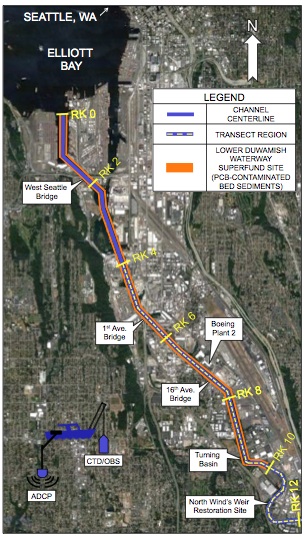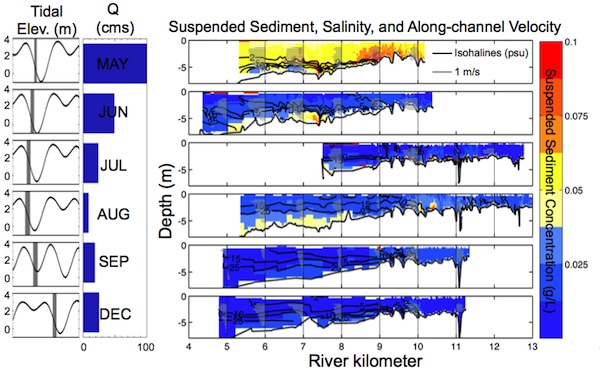 Continuously modified since 1890, the Duwamish River estuary near Seattle WA has lost 98% of its intertidal area and accumulated enough legacy contaminants to justify four EPA-designated Superfund sites. Yet the estuary has retained a surprising amount of biological activity. The primarily hydrophobic contaminants sorb onto fine sediments and are concentrated in the bed, thus predicting the fate of the contaminants requires an understanding of the mechanisms suspending, transporting, and depositing the sediments. Sediment transport processes are well studied in partially-mixed estuaries and the strongly stratified Duwamish provides an opportunity to examine these processes in a salt-wedge estuary. We use monthly observations beginning in May 2011 to characterize tidal-scale hydrodynamic and sediment transport processes. We observe that low riverflow in the summer maintains the contaminated reach continuously within the salt-wedge. High winter discharges push the toe downstream, periodically exposing the contaminated bed to the higher stresses upstream of the salt-wedge. Measuring the present sensitivity of the system to tidal and fluvial forcing provides a framework to explore the impacts of sea-level rise and riverflow variability expected by climate change models.
Continuously modified since 1890, the Duwamish River estuary near Seattle WA has lost 98% of its intertidal area and accumulated enough legacy contaminants to justify four EPA-designated Superfund sites. Yet the estuary has retained a surprising amount of biological activity. The primarily hydrophobic contaminants sorb onto fine sediments and are concentrated in the bed, thus predicting the fate of the contaminants requires an understanding of the mechanisms suspending, transporting, and depositing the sediments. Sediment transport processes are well studied in partially-mixed estuaries and the strongly stratified Duwamish provides an opportunity to examine these processes in a salt-wedge estuary. We use monthly observations beginning in May 2011 to characterize tidal-scale hydrodynamic and sediment transport processes. We observe that low riverflow in the summer maintains the contaminated reach continuously within the salt-wedge. High winter discharges push the toe downstream, periodically exposing the contaminated bed to the higher stresses upstream of the salt-wedge. Measuring the present sensitivity of the system to tidal and fluvial forcing provides a framework to explore the impacts of sea-level rise and riverflow variability expected by climate change models.

People: Maggie McKeon, Alex Horner-Devine
Acknowledgements: University of Washington Royalty Research Fund, Gravity Environmental, Sea-Bird Electronics, South Park Marina
